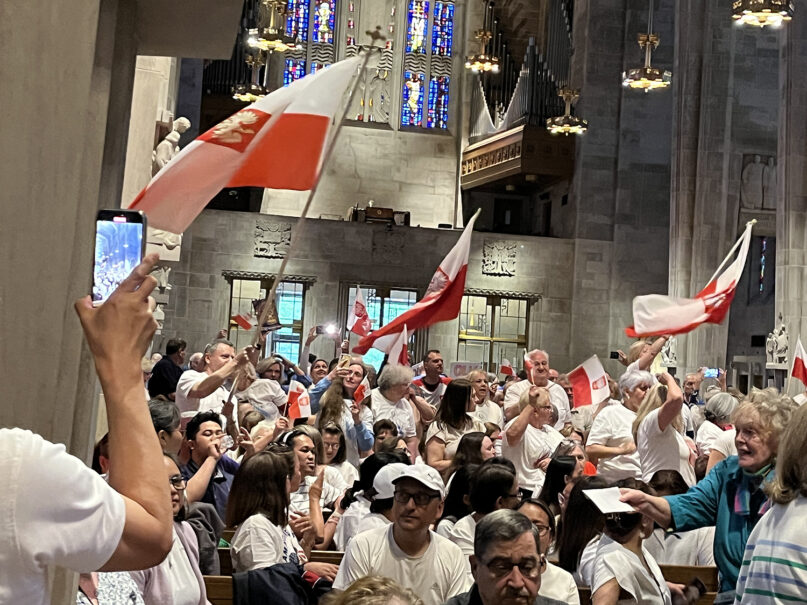BALTIMORE (RNS) — Patrice Ellerbe, a 65-year-old parishioner at St. Veronica, had come to the Cathedral of Mary Our Queen on April 30 for a public forum on the Archdiocese of Baltimore’s proposed plan for closing about two-thirds of parishes in the city. She knew the bad news already: Two weeks before, the archdiocese had announced that her 79-year-old Black Catholic parish was among those proposed to close.
“It felt like a punch in the stomach,” she said, a feeling the more than 1,000 Catholics gathered at the cathedral to give their feedback seemingly shared. As the plan was read out, the high arched ceilings of the nave began to echo with boos.
The closures, in the nation’s oldest Catholic diocese, are part of a nationwide trend of restructuring in response to falling Mass attendance and priest shortages. In explaining the need to close Baltimore parishes, the archdiocese has focused on the first reason, pointing to weekend Mass attendance that has fallen below 8,000 in a city that used to have 250,000 active Catholics. At most churches, officials say, funerals outnumber baptisms.
The archdiocese has also emphasized that the city’s population has fallen by 38% since 1950 and have noted the high costs of maintaining church buildings.
“It’s getting harder to do more with less, many of the existing City parishes struggle to fulfill its Eucharistic vision due to the many challenges they face,” said Christian Kendzierski, executive director of communications for the archdiocese, in an email.

The Cathedral of Mary Our Queen hosted a public forum for ongoing conversations for the closure of about two-thirds of parishes across Baltimore. (RNS photo/Aleja Hertzler-McCain)
But for the remaining faithful, the habits of Catholic faith are deeply engrained. On Sundays, Ellerbe said, she makes the drive across the city to St. Veronica, in south Baltimore’s Cherry Hill neighborhood, where she was baptized. “It’s home for me,” she said.
In two previous draft proposals, St. Veronica had been selected as the host church for other parishes to merge into, Ellerbe said. If Archbishop William Lori approves the proposed plan, she will likely be attending at St. Rose of Lima, 2 miles away, or at a potential additional worship site in a nearby shopping center.
Black neighborhoods have disproportionately borne the brunt of parish closures in other dioceses across the country, but in Baltimore, six of the city’s 16 Black Catholic parishes are proposed to remain open, roughly in proportion to the citywide closure rate.
In the cathedral, Filipino Catholics led chants of “Save our shrine” and others waved the red-and-white Polish flag, each defending their parishes. Ellerbe doubted any would be mollified. “It’s so much data. It’s so organized,” she said of the plan.
Lori announced Seek the City to Come, billed as a process to “enable” the city of Baltimore to “become more fully alive and better serve the diverse needs of our faith community,” in September 2022, warning that closures were possible. The archdiocese has since conducted daylong visits to each parish, released a survey online and by phone and held regional and online listening sessions, as well as workshops for envisioning the future of the city’s ministries.

Debra Tagle was one of several members of the Filipino community who attended the forum with banners to advocate against the closure of additional facilities. (RNS photo/Aleja Hertzler-McCain)
Although some at the public comment forum admonished others for their behavior and reminded the crowd that there had been many previous opportunities to get involved in the process, the archdiocese still came under blistering criticism.
“This is a bad plan that will have long-lasting negative impact on these communities and will cause irreparable damage to an already badly tarnished reputation of the Catholic Church,” said Maria Nemcek, a parishioner at St. Clement Mary Hofbauer, predicting it would cause Catholics to leave the church. She accused the archdiocese of doing too little to attract new families to the faith.
Opposition to parish closures is about “tradition and memories and the incarnational presence of Christ in the community,” said Susan B. Reynolds, assistant professor of Catholic studies at Emory University’s Candler School of Theology, but it can become a “proxy battle, kind of a referendum on the authority of the church itself.”
The percentage of Americans identifying as Catholic has dropped from 24% in 2007 to 20% in 2023, according to Pew Research Center. In a PRRI poll, 45% of former Catholics cited the clergy sexual abuse crisis as a reason for leaving. Among people of any faith who no longer attend, 47% cited negative teachings about or treatment of gay and lesbian people.

Community members gathered for a discussion on the potential closure of churches in the Baltimore Archdiocese. (RNS photo/Aleja Hertzler-McCain)
In the new parishes that the archdiocese envisions, parishes housed in traditional churches will draw more than 500 people to weekend Masses. A few smaller parishes will meet in nontraditional sites, such as strip malls.
Reynolds said that, while these models prioritize financial stability through large parishes, the archdiocese is losing out on the value of small communities, especially in the urban context. “You cease to be present among the poorest of the poor in a city, on the margins, among the most vulnerable,” she said.
“These are some of the most powerful witnesses to the gospel that we have. These are spaces of intimacy and love that are really irreplaceable,” Reynolds added. “That reality of communion, of solidarity, of being the body of Christ is so alive in a small community.”
Reynolds predicted Baltimore’s closures will have long-term impacts, noting that in Boston, where between a fourth and a fifth of the city’s parishes were closed in 2004, the first large-scale closures in the current era, “the legacy of those closures is still really deeply felt by Catholics there.”
Boston’s closures inspired fierce resistance, including multiple sit-ins in closed parishes. At St. Frances Xavier Cabrini, parishioners staged a 24/7 sit-in for more than 11 years.

Baltimore parishioner Sam Moxley is worried about the potential closure of churches in his archdiocese and the impact it could have on the community. (RNS photo/Aleja Hertzler-McCain)
One lesson from Boston, Reynolds said, is that the archdiocese must invest in helping the combined parishes build a new sense of identity. Parishioners are coming from a place of woundedness, she said, and may be lack the energy to rebuild.
Many Baltimore Catholics expressed concern that ministry to poor and vulnerable people will vanish with their parish. Baltimore resident Sam Moxley told Religion News Service he drives past multiple Catholic churches to go to St. Joseph’s Monastery because “the gospel gets preached from the pulpit, but we preach Jesus Christ on the streets.” He said he worries about leaving the community around the parish behind if the proposed closure goes through.
Baltimore Auxiliary Bishop Bruce A. Lewandowski said at the April 30 session that, with fewer buildings to maintain, the archdiocese could focus more on ministry and outreach, but specifics about such programs will only come in a future implementation phase.
Immigrant Catholics shared deep pain at the cathedral at the thought of parish closures. One parishioner, from Our Lady of Victory, on the far southwest edge of Baltimore, said that many of the parish’s members had fled Myanmar’s military dictatorship.
“When we were strangers in a new land, there was only one place that felt like home,” the parishioner said. “Losing our community home feels especially cruel and traumatic.”
Debra Tagle, who attends the Shrine of the Sacred Heart, told RNS that the Filipino community at her parish had shown up with banners and chants because, as immigrants, the shrine “is the only place where we feel so welcome, and this is our home.”
At a separate Spanish-language feedback session at Our Lady of Fatima in east Baltimore on April 29, it was clear the parish closures would hit hard for Latinos as well.
Lewandowski told Latino Catholics that, in 2022, out of 850 baptisms in the city, 450 occurred in just four predominantly Hispanic parishes. Yet, two of those four parishes are slated to close.
“Our community is growing,” the bishop told Latinos in Spanish. “The truth is that what we’re asking of you, in a sense, is to make a sacrifice, to extend a hand, to share some of our community’s treasure.”

Community members attended a forum with signs and banners to discourage the closing of facilities. (RNS photo/Aleja Hertzler-McCain)
The Latino Catholics, who, unlike the English-speakers, received a lecture on respect before the discussion began, were more subdued in their criticism of the proposal. Like the group at the cathedral, they cited concerns with continuing ministries, impact on children, transportation and parking and space at combined parishes, even as many Latinos spoke of obedience.
“We are willing for the changes to be made in the church, but we feel that even the church is rejecting us,” one parishioner from St. Clare, a parish proposed to close, said.
Spanish- and English-speaking Catholics alike expressed hope that, given the chance, they could fill their pews by turning their attention to evangelization. Some pleaded with the archdiocese to give them more time.
Despite Baltimore’s historic place in American Catholic history, Reynolds said it would be inaccurate to describe the city’s parish closures as a sign that American Catholicism is dying, especially as Catholicism is growing in the Southwest and Southeast.
“You have a changing religious landscape. You have a changing landscape of Mass attendance and practice. Many of these buildings are more than a century old. You need to do something. It’s kind of the problem of reality,” she said.





